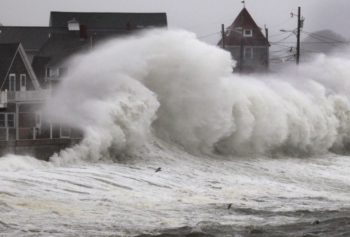 In a significant victory for farmers, ranchers, and other landowners, the Trump administration December 11 pulled the plug on an Obama-era regulatory scheme that would have subjected millions of acres of private land to federal zoning.
In a significant victory for farmers, ranchers, and other landowners, the Trump administration December 11 pulled the plug on an Obama-era regulatory scheme that would have subjected millions of acres of private land to federal zoning.
By rolling back Obama’s 2015 “Waters of the United States” (WOTUS) rule, the administration has put an end to the biggest power grab in the 48-year history of the Environmental Protection Agency (EPA).
The Obama-era rule was sold as an effort to “clarify” the federal government’s jurisdiction over bodies of water under the 1972 Clean Water Act (CWA), which granted EPA and the U.S. Army Corps of Engineers jurisdiction over “navigable waters of the United States.”
Over the years, questions arose over whether Washington also had jurisdiction over bodies of water, which may not be navigable themselves, but which are adjacent to or have some connection to, navigable waters.
The Supreme Court’s 2006 Rapanos v. United States decision failed to resolve the issue, with Justice Anthony Kennedy infamously opining that federal jurisdiction extended to such waters provided they had a “significant nexus” to navigable waters.
The Power Grab
What constituted a “significant nexus” was anyone guess, leaving landowners, municipalities, businesses, and just about everyone else completely in the dark.
Eager to take advantage of a murky situation and beef up EPA’s enforcement authority, the Obama administration in 2015 proposed “clarifying” the issue by greatly expanding EPA’s jurisdiction to include ditches, ponds, groundwater, and even “ephemeral” waters (those that form only after rainfall).
The rule would have forced farmers, ranchers, and other landowners to obtain permits from EPA if they wanted to make any modifications to their property.
A host of organizations sued EPA and a federal judge ordered a stay on the rule in 24 states.
Having vowed to kill the rule during the 2016 presidential campaign, President Trump issued an executive order in February 2017 directing EPA to carry out the “elimination of this very destructive and horrible rule.”
Trump’s first EPA Administrator, Scott Pruitt, tried to delay implementation of the Obama WOTUS rule, but a U.S. district court in South Carolina invalidated the delay in August 2018.
Now, the Trump administration has its own plan for untangling the jurisdictional mess that has surrounded the regulation of waterways for decades.
What is and What is not Subject to Federal Regulation
“Our proposal would replace the Obama EPA’s 2015 definition with one that respects the limits of the Clean Water Act and provides states and landowners the certainty they need to manage their natural resources and grow local economies,” said Acting EPA Administrator Andrew Wheeler in a statement. “For the first time, we are defining the difference between federally protected waterways and state protected waterways.”
Under the Trump proposal, the federal government, for the first time, has divided navigable waters into six categories:
- Traditional navigable waters (rivers, bays, the Great Lakes, etc.);
- Waterways connected to navigable waters, including tributaries;
- Specific navigable ditches used for commercial shipping, such as the Erie Canal;
- Lakes and ponds that contribute to navigable waterways;
- Impoundments of jurisdictional waterways; and
- Wetlands adjacent to navigable waterways through “direct subsurface connection.”
Trump’s WOTUS proposal also clearly states what EPA and the Corps of Engineers will not regulate.
These include “features that only include water during or in response to rainfall (e.g., ephemeral features); groundwater; many ditches, including most roadside or farm ditches; prior converted cropland; stormwater control features; and waste treatment systems.”
Acting EPA Administrator Wheeler, who has been nominated for the top job at the agency by President Trump, points out that most bodies of water not covered under the new proposal are still subject to state protection.
“We don’t need to have the dual protection and the dual requirements and permits at both state and federal levels,” he said on the Hugh Hewitt radio show (Washington Times, Dec. 12).
The difference between the Obama and Trump approaches cannot be understated. A 2015 American Farm Bureau Federation study, for example, found that 99% of Pennsylvania would be subject to the Obama WOTUS rule.
“This new rule will empower farmers and ranchers to comply with the law, protect our water resources, and productively work their land without having to hire an army of lawyers and consultants,” said farm bureau president Zippy Duvall (Washington Times, Dec. 12).
The fight is far from over, with environmental groups expected to bring suit against EPA and the Corps.
There will be a 60-day public comment period that will last until mid-February 2019.
Read more at CFACT

















Power grab? It was a land grab.
If you own farmland, how do you prevent rain from soaking it? I’m a farmer in Ontario. I only have rights to my land to the depth that I till it. I think.
As we all the the Eco-Wackos/Nature Freaks only want the land open for themselves and their wealthy supporters from Hollywood like Robert Redford and Leonardo DiCaprio this land was meant for us to use after all we live in a Republic and not a Monarcy that the way our Founding Fathers wanted it not locked away from the American Public over some dumb Lizard or Rodent